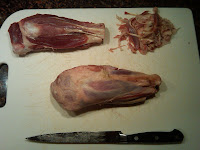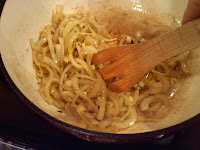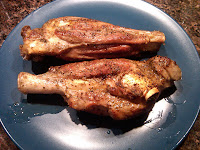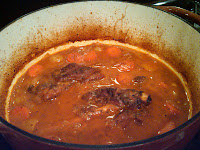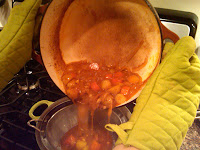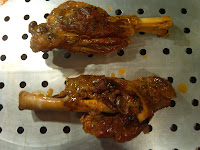
 The second I saw the recipe for Peanut Butter Chocolate Cupcakes in Barefoot Contessa's book, I knew I would be making them, because I am an unabashed sucker for classic peanut butter/chocolate combinations. You don't see as many peanut butter chocolate cupcakes in the cupcake world as you'd initially think considering the dominance of the peanut butter chocolate combination in the rest of the sweet/dessert/candy market. The best reason I can give for this is that these cupcakes are RICH. Not cloyingly sweet, just very, very rich. This is one of the reasons why the lightness of the texture in the cupcakes (that you get by creaming the batter almost like you're making frosting or cookie dough at the beginning) is such a good match. The end result is essentially a Tagalong cupcake.
The second I saw the recipe for Peanut Butter Chocolate Cupcakes in Barefoot Contessa's book, I knew I would be making them, because I am an unabashed sucker for classic peanut butter/chocolate combinations. You don't see as many peanut butter chocolate cupcakes in the cupcake world as you'd initially think considering the dominance of the peanut butter chocolate combination in the rest of the sweet/dessert/candy market. The best reason I can give for this is that these cupcakes are RICH. Not cloyingly sweet, just very, very rich. This is one of the reasons why the lightness of the texture in the cupcakes (that you get by creaming the batter almost like you're making frosting or cookie dough at the beginning) is such a good match. The end result is essentially a Tagalong cupcake.The Nutella version of the frosting is moister, due to the higher oil content of Nutella, or at least this is what I am assuming because just like Nutella cookies are flatter and rise less than peanut butter cookies, this frosting just doesn't cream quite as well as the peanut butter version. This leads to a different but still very pleasant experience because Nutella is basically instant goodness on everything it touches. The salt in the frosting leaves a nice, noticeable, welcome kick to the frosting. I used kosher salt, but if you'd prefer, you can use a finer grain. Unlike baking, frosting measurements really don't have to be super accurate, so feel free to experiment with amounts until it reaches a stiffness and sweetness of your liking. My only strong recommendation is that you make sure your ingredients are room-temperature before using them, especially the butter. Cold butter just doesn't cream as well, and both the cupcakes and the frosting really get their great consistency from creamed butter.
Barefoot Contessa writes all of her baking for a standing mixer, but given the size of my urban kitchen, I'm a hand mixer kind of gal, so I've adapted it. By the way, an investment in a good quality hand mixer with clear differences in speeds (a distinct low, medium low, medium, medium-high, and high) is a solid way to invest in kitchenware if you plan on baking. A good one will last decades. A cheap target one will fail you in delicate recipes (luckily, this is NOT that delicate of a recipe).
Peanut Butter/Nutella Chocolate Cupcakes
Ingredients
| Peanut Butter Icing 1 cup confectioners' sugar 1 cup creamy peanut butter 5 tablespoons unsalted butter, at room temperature 3/4 teaspoon pure vanilla extract 1/4 teaspoon kosher salt 1/3 cup heavy cream | Nutella Icing 1 1/4 cup confectioners' sugar, plus more if needed for added stiffness 1 cup Nutella 5 tablespoons unsalted butter, at room temperature 1/4 teaspoon pure vanilla extract 1/4 teaspoon kosher salt 1/2 cup heavy cream |
 |
| Fluffy batter= fluffy cupcake |
 |
| Creaming peanut butter frosting |
 |
| Use a round 1/4 cup measure |
Cupcakes
- Preheat the oven to 350 degrees F. Line cupcake pans with paper liners.
- In a large bowl, cream the butter and 2 sugars with an electric hand mixer on high speed until light and fluffy, approximately 5 minutes.
- Lower the speed to medium, add the eggs 1 at a time, then add the vanilla and mix well.
- In a separate medium bowl, whisk together the buttermilk, sour cream, and coffee.
- In another medium bowl, sift or whisk together the flour, cocoa, baking soda, and salt.
- On low speed, add the buttermilk mixture and the flour mixture alternately in thirds to the mixer bowl, beginning with the buttermilk mixture and ending with the flour mixture. Mix only until blended.
- Push down on the sides with a rubber spatula, then fold the batter with a rubber spatula to be sure it's completely blended.
- Divide the batter among the cupcake pans (1/4 cup measure or a rounded ice cream scoop per cupcake).
- Bake in the middle of the oven for 20 to 25 minutes, until a toothpick comes out clean.
- Cool for 5 minutes, remove from the pans, and allow to cool completely before frosting.
Frosting
- Place the confectioners' sugar, peanut butter, butter, vanilla, and salt in a medium sized bowl.
- With an electric mixer, mix ingredients on low until powdered sugar is combined.
- Move to medium-low speed until creamy, scraping down the bowl with a rubber spatula as you work. For the nutella icing, the consistency will be thicker, almost like a very soft fudge. For the peanut butter icing, the consistency will be more like a traditional butter cream.
- Add the cream and beat on high speed until the mixture is light, fluffy and smooth, and has increased in volume, like a store bought butter cream. (The nutella version may be slightly moister).


















